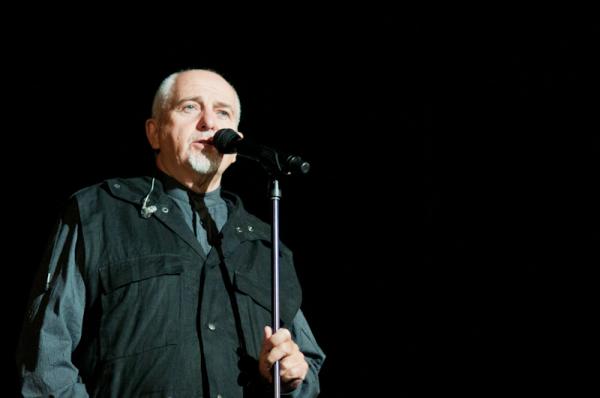Peter Gabriel, Sonic Sledgehammer

When live sound is as good as it was at Peter Gabriel’s show at the Wells Fargo Center in Philadelphia on September 21, I felt like I had to pinch myself to believe it. I mean, was I really hearing what I was hearing?
Of course I was. This is Peter freakin’ Gabriel we’re talking about here, so it’s not exactly a surprise. The onetime Genesis frontman-cum-Real World music progenitor has been a stickler for sound quality — and video innovation — for decades. In the “Tech Talk” portion of the tour book, Gabriel states, “I inherited my passion for music from my mum and a passion for technology from my dad, who is now a 100 year old electrical engineer and inventor.” I asked Gabriel if he felt sound quality still mattered and if surround sound had a future at a press event at the Supper Club in New York City on September 24, 2002, and he was firm in supporting both ideas/ideals. And when I saw the Growing Up tour in the round at the Continental Arena in East Rutherford, New Jersey not long after that on November 17, 2002 from essentially a ringside seat, I marveled at the nuances of the live mix, the likes of which I’ve rarely experienced in an arena setting.
The current, brief 16-date fall tour has been dubbed Back to Front 2012, which commemorates the 25th anniversary of the groundbreaking So album (give or take a year, that is), and it reunites the original touring band, which embodies the cliché “stronger than ever” to its very core: guitarist David Rhodes, bassist Tony Levin, drummer Manu Katché, and keyboardist/accordionist David Sancious. (Jennie Abrahamson and Linnea Olsson handled the background vocals, the latter filling in for the absent, ailing Ane Brun.)
From my second-row, essentially-penalty-box-level seat in Philly — which was about 20 rows deep from stage right — I again reveled in my appreciation for the house mix, courtesy of longtime PG collaborator, front-of-house sound engineer Ben Findlay (who also supervises the live mixes of each show that are made available to the public; more on that in a bit).
The 136-minute set was broken into three segments: Acoustic (four songs stripped down, and with the house lights on for most of it), Retro (six favorites), and So (the album played in full, in essentially the original running order). The second song of the Acoustic set, “Come Talk to Me,” set the aural tone for the show. Katché’s cymbal and hi-hat work was clean, clear, and sharp, supplemented by Sancious’s accordion and Gabriel’s own piano. Each element was distinct and not muddy — not easy to accomplish in a space like this. Gabriel’s lead vocal was strong and never raspy (and remained as strong all night). In fact, I prefer this “Talk” arrangement to the busier, burbly original from 1992’s Us.
Rhodes added some keen Frippian guitar textures to the second song in the Retro set, “The Family and the Fishing Net,” and Levin was a bottom-end master throughout the evening, whether it was the subtle standup Stick lines coloring the Acoustic set opener, the in-progress “OBUT” — a new song, of which Gabriel playfully pleaded when it was done, “If anyone has some words to that…” — to the distinct bassline break in the So set’s pivotal “Don’t Give Up.” (Abrahamson gamely handled the soothing Kate Bush parts, her occasionally “girly” tone admittedly giving them a bit of a new twist.)
When the So set commenced, I was instantly immersed in the one-two punch of “Red Rain” (with Levin donning those magical Funk Fingers to attack his bass while Katché’s snare hits getting me square in the chest) and “Sledgehammer” (with Gabriel mock-slamming his fists to both sides of his head on the audience-reinforced chorus).
The light show, as expected, was marvelously innovative, with six tall, black rolling stands with three lights apiece bobbing and weaving across and around the bandmembers and the stage at will — or when they were physically moved around by “the men in black,” as Gabriel dubbed them. When Gabriel laid down on his back on a target on the stage for a subdued take on “Mercy Street,” the cameras in the white, puck-like fixture above him zeroed in and panned over his body as if looking for clues to find (to borrow a line from another song) the places he got hurt.
The encore was truly ethereal, with Gabriel fully enveloped by a giant white spiral for the climax of the oh-so-aptly-named “The Tower That Ate People” and the audience being fully engaged by the solemn, always heartfelt and deeply impactful closer, “Biko.”
Back to Front was truly exhilarating from, well, front to back — and it’s relivable. If you want to hear any of the shows from this tour (as any SQ enthusiast should), go to petergabriel.com and search for the Encore Series, which will take you to where you can choose any, or all, of the Findlay-mixed shows you desire.
- Log in or register to post comments














































